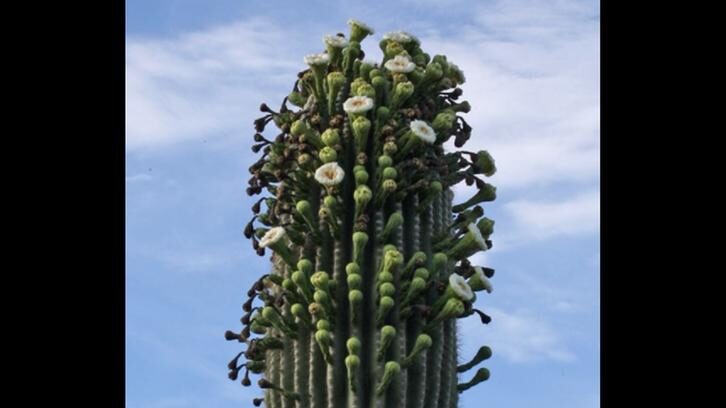
Saguaros, which can live for centuries and grow to nearly 80 feet, have erupted in spring blooms that are spreading far beyond the norm. It's almost as if the plants are breaking out in a rash of blooms.
This is happening in the Sonoran Desert and experts suspect it may be an example of how the warming environment is impacting even the oldest of plants.
"Tucson residents are witnessing an extremely rare phenomenon: saguaro blooms are literally busting out all over," the Sonoran Desert Network & Desert Research Learning Center reported May 26 on Facebook.
"Saguaros typically bloom in spring. And when they do, the blooms are usually confined to a crown at the very top of the main body or mature arms," the center wrote. "But after an unseasonal bloom last fall, saguaro flowers are now appearing down the length of main stems and arms, and — remarkably — even on small buds."
The odd behavior takes on added significance given the saguaro's long life span.
"An adult saguaro is generally considered to be about 125 years of age," the National Park Service reports. "The average life span of a saguaro is probably 150-175 years of age. However, biologists believe that some plants may live over 200 years."
Saguaro are considered to be a "symbol of the American west," yet they are rare, NPS officials say. "These majestic plants, found only in a small portion of the United States, are protected by Saguaro National Park" near Tuscon.
While beautiful, the flowering phenomenon is foreboding, leaving botanists wondering what will happen next. There has been anecdotal evidence in the past year that other plants are blooming out of season across the country, including prickly pears in Arizona, hyacinth bulbs in Illinois, and aloe vera in Southern California, McClatchy News reported last year.
"The reasons for all this are unclear, but it's notable that 2020 brought Tucson its hottest summer and second-driest monsoon on record — leading some longtime observers to hypothesize that the extraordinary bloom is a stress response," the center wrote.
"Whether this current reproductive profusion results in widespread saguaro recruitment will depend on what happens next."



Comment: Erratic seasons, extreme weather events and overall global cooling are signs that something much greater is afoot on our planet:
- Plants blooming 20 days earlier over last 30 years
- Highly pathogenic bird flu outbreak already reported in 46 countries, has spread to humans with 862 cases
- UK's mild winter disrupting animal hibernation and insect behavior
- Extreme weather & disease: The fight to save Europe's olive trees
And check out SOTT Radio's: